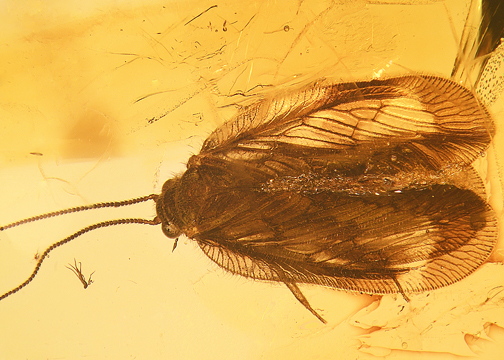Abstract
A new species of the lacewing family Hemerobiidae, Pseudonotherobius fenestromaculatus sp. nov., is described from the Eocene Baltic amber. The new species is assigned to Pseudonotherobius based on the following characters: the forewing RP with three ORBs, the ORB1 and CuP deeply forked, and the presence of dark brown coloration. The species can be distinguished from Pseudonotherobius kohlsi Makarkin, 2024 by the forewing membrane medially with a large dark marking from costal margin to M vein along third gradate series, and distally with a broad dark marking covering whole wing apex. Our finding provides new evidence for understanding the palaeodiversity of brown lacewings from the Tertiary.
References
- Adams, P.A. (1996) Venational homologies and nomenclature in Chrysopidae, with comments on the Myrmeleontoidea. In: Canard, M., Aspöck, H. & Mansell, M.W. (Eds), Pure and Applied Research in Neuropterology. Proceedings of the Fifth International Symposium on Neuropterology. Privately printed, Toulouse, pp. 19–30.
- Breitkreuz, L.C., Winterton, S.L. & Engel, M.S. (2017) Wing tracheation in Chrysopidae and other Neuropterida (Insecta): a resolution of the confusion about vein fusion. American Museum Novitates, 3890, 1–44. https://doi.org/10.1206/3890.1
- Engel, M.S. & Grimaldi, D.A. (2007) The neuropterid fauna of Dominican and Mexican amber (Neuropterida: Megaloptera, Neuroptera). American Museum Novitates, 3587, 1–58. https://doi.org/10.1206/0003-0082(2007)3587[1:TNFODA]2.0.CO;2
- Garzón-Orduña, I.J., Menchaca-Armenta, I., Contreras Ramos, A., Liu, X.Y. & Winterton, S.L. (2016) The phylogeny of brown lacewings (Neuroptera: Hemerobiidae) reveals multiple reductions in wing venation. BMC Evolutionary Biology, 16, 1–19. https://doi.org/10.1186/s12862-016-0746-5
- Jarzembowski, E.A. (1980) Fossil insects from the Bembridge Marls, Palaeogene of the Isle of Wight, southern England. Bulletin of the British Museum of Natural History, Geology, 33, 237–293.
- Jepson, J.E., Penney, D. & Green, D.I. (2010) A new species of brown lacewing (Neuroptera: Hemerobiidae) from Eocene Baltic amber. Zootaxa, 2692 (1), 61–68. https://doi.org/10.11646/zootaxa.2692.1.4
- Li, S.M., Ren, D., Yang, Q. & Shi, C.F. (2023) A new brown lacewing (Neuroptera: Hemerobiidae) from mid-Cretaceous Myanmar amber. Palaeoentomology, 6 (5), 533–541. https://doi.org/10.11646/palaeoentomology.6.5.12
- Makarkin, V.N. (1991) Miocene lacewings (Neuroptera) from the northern Caucasus and Sikhote-Alin. Paleontologicheskii Zhurnal, 1991, 57–68. [In Russian with English translation. Paleontological Journal, 25, 55–65 (1992)]
- Makarkin, V.N. (2023) Fossil Hemerobiidae (Neuroptera) from the Eocene Tadushi Formation, the Russian Far East, with description of a new genus. Zootaxa, 5297 (1), 115–123. https://doi.org/10.11646/zootaxa.5297.1.6
- Makarkin, V.N. (2024) First brown lacewings (Neuroptera: Hemerobiidae) from the early Eocene Green River Formation. Zootaxa, 5501 (1), 160–170. https://doi.org/10.11646/zootaxa.5501.1.7
- Makarkin, V.N. & Perkovsky, E.E. (2020) A new species of Proneuronema (Neuroptera: Hemerobiidae) from late Eocene Rovno amber. Zootaxa, 4718 (2), 292–300. https://doi.org/10.11646/zootaxa.4718.2.11
- Makarkin, V.N. & Wedmann, S. (2009) First record of the genus Sympherobius (Neuroptera: Hemerobiidae) from Baltic amber. Zootaxa, 2078 (1), 55–62. https://doi.org/10.11646/zootaxa.2078.1.3
- Makarkin, V.N., Archibald, S.B. & Oswald, J.D. (2003) New early Eocene brown lacewings (Neuroptera: Hemerobiidae) from western North America. Canadian Entomologist, 135, 637–653. https://doi.org/10.4039/n02-122
- Makarkin, V.N., Perkovsky, E.E. & Gröhn, C. (2019) Neotype designation and re-description of Prolachlanius resinatus (Hagen) (Neuroptera, Hemerobiidae) from Baltic amber, with the first record of the species from Rovno amber. Zootaxa, 4688 (1), 57–70. https://doi.org/10.11646/zootaxa.4688.1.2
- Makarkin, V.N., Wedmann, S. & Weiterschan, T. (2016) A new genus of Hemerobiidae (Neuroptera) from Baltic amber, with a critical review of the Cenozoic Megalomus-like taxa and remarks on the wing venation variability of the family. Zootaxa, 4179 (3), 345–370. https://doi.org/10.11646/zootaxa.4179.3.2
- Nel, A. & Jarzembowski, E.A. (2019) New lacewings from the Insect Bed (late Eocene) of the Isle of Wight (Neuroptera: Nemopteridae, Chrysopidae, Hemerobiidae). Earth and Environmental Science Transactions of the Royal Society of Edinburgh, 110 (3-4), 397–403. https://doi.org/10.1017/S1755691018000476
- New, T.R. (1988) Hemerobiidae (Insecta: Neuroptera) from New Guinea. Invertebrate Systematics, 2, 605–632. https://doi.org/10.1071/IT9880605
- Oswald, J.D. (1993) Revision and cladistic analysis of the world genera of the family Hemerobiidae (Insecta: Neuroptera). Journal of the New York Entomological Society, 101, 143–299.
- Oswald, J.D. (chief editor) (2024) Lacewing Digital Library. Available from: https://lacewing.tamu.edu (Accessed 31 August 2024).
- Panfilov, D.V. (1980) Novye predstaviteli setcharokrylykh (Neuroptera) iz yury Karatau. In: Dolin, V.G., Panfilov, D.V., Ponomarenko, A.G. & Pritykina, L.N. (Eds), Iskopaemye nasekomye mezozoya. Akademiya Nauk Ukrainskoi SSR, Institut Zoologii, Naukova Dumka, Kyiv, 82–111.
- Ponomarenko, A.G. (1992) Neuroptera (Insecta) from the Lower Cretaceous of Transbaikalia. Paleontologicheskii Zhurnal, 1992, 43–50. [In Russian]
- Sadowski, E.-M., Schmidt, A.R., Seyfullah, L.J. & Kunzmann, L. (2017) Conifers of the “Baltic amber forest” and their palaeoecological significance. Stapfia, 106, 1–73.


